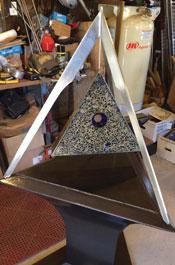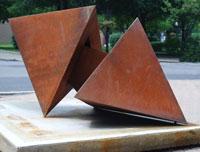- FMA
- The Fabricator
- FABTECH
- Canadian Metalworking
Categories
- Additive Manufacturing
- Aluminum Welding
- Arc Welding
- Assembly and Joining
- Automation and Robotics
- Bending and Forming
- Consumables
- Cutting and Weld Prep
- Electric Vehicles
- En Español
- Finishing
- Hydroforming
- Laser Cutting
- Laser Welding
- Machining
- Manufacturing Software
- Materials Handling
- Metals/Materials
- Oxyfuel Cutting
- Plasma Cutting
- Power Tools
- Punching and Other Holemaking
- Roll Forming
- Safety
- Sawing
- Shearing
- Shop Management
- Testing and Measuring
- Tube and Pipe Fabrication
- Tube and Pipe Production
- Waterjet Cutting
Industry Directory
Webcasts
Podcasts
FAB 40
Advertise
Subscribe
Account Login
Search
Visual reality
Broad interests shape metal artist’s unique perspective
- By Amanda Carlson
- June 13, 2012
- Article
- Shop Management

Figure 1: “Eye of Providence” combines smooth metal surfaces with polished concrete smattered with pieces of broken sake bottles. Experimenting with the two materials has been a fun process for Turan.
To pursue visual art or science, that is the question.
Polar-opposite interests? Yes. But who says the two can’t intersect somehow. After all, elements of science are alive in metal forming and fabricating, but to make it visually pleasing, an artist’s touch is necessary. Metal art, it would seem, satisfies both worlds. For someone like artist and advertising executive Bob Turan, it couldn’t be more perfect.
As a college student at Rensselaer Polytechnic Institute, Turan was torn between two disciplines—art and science.
“I’ve always been both a right-brained and left-brained kind of guy. I liked technical things but I also had an artistic streak. I didn’t know if I wanted to be an artist or an astronaut,” Turan explained.
So he tried both, making the rounds first as a physics major and then as an architecture major before finally settling on a degree in psychology. After graduating from college in the late 1960s, Turan enlisted in the Navy, where he hooked up with the Atlantic Fleet Combat Camera Group based in Norfolk, Va. There he added film experience to his still-photography background.
“When I first heard about it, I thought, ‘Oh my gosh, they’re going to be shooting at me and all I’ll have is a camera to shoot back!’”
After his stint in the Navy, Turan worked as a documentary filmmaker before moving to upstate New York to pursue a career in advertising.
Art Sense
Turan’s metal sculpture story began about 12 years ago. He enrolled in welding classes; read books on welding theory; and started seeing the potential in discarded metal, like old bicycles and metal guardrails.
His pieces were small, at first—wall hangings, tabletop sculptures, and others for indoor display. The more pieces he sold, the more metalworking equipment he purchased. With more equipment came a boldness to try bigger, more complex pieces. Relying heavily on found metal used in combination with new steel, concrete, and other materials, Turan lets his imagination work in cooperation with the equipment that he’s acquired through the years.
“It’s different with most pieces. If I’m working with found objects, it’s just a matter of figuring out what the pieces are trying to tell me.”

Figure 2: “Triangle Tango”’s rusted effect is from the COR-TEN steel it’s fabricated from. The steel is designed to oxidize gradually.
He allows the shapes and sometimes the finish of the metal pieces to guide him through the build process, admitting that an original concept is likely to change during assembly.
“Often I’ll change my mind as things come together. I’ll typically try and draw something out or I’ll have an idea in my mind of what I want to do. Once I start burning metal, sometimes the laws of physics and gravity come into play and I have to do some problem solving.
“I like to make kinetic pieces; I like things that turn or swing so that it’s more than just 3-D, it’s 4-D, with time being the fourth dimension. That’s where some of my cinematic background comes into play,” Turan said.
But it’s his visual art sensibilities that allow him to combine concrete and steel almost seamlessly. In “Eye of Providence,” the focal point is a concrete triangle with pieces of broken blue sake bottles and a bottleneck serving as the eye (see Figure 1).
Turan used a 3-ft. rolling machine and an 8-ft. brake belonging to Fine Architectural Metalsmiths, Florida, N.Y., to shape the bottom section. He assembled the pieces in his studio and fabricated a stainless steel tripod stand using boiler steel scrap.
Although many artists outsource repeatable parts, Turan prefers to perform the work with his mind and his own two hands.
“I like to say it’s robot-free. Whether it’s arc welded, MIG welded, or gas welded, it’s done by hand. If I make a mistake, I go back and fix it. I like the hands-on aspect.”
Free-Flowing
Right now Turan’s equipment limits his cutting capabilities to mostly straight lines and geometric shapes, like “Triangle Tango” (see Figure 2). Fabricating it out of 11-ga. COR-TEN® steel, Turan cut the sheet with an 8-in. circular saw. For cutting thicker-gauge material, like that used in “Music of the Squares,” he uses an oxyacetylene torch, which leaves a rough edge and provides a nice contrast to smooth surfaces (see Figure 3). He plans on adding a plasma cutter to his toolbox to achieve more free-flowing shapes.
“You’ll see a change in my work as I get new equipment. With a plasma cutter, I’m going to start building things with cleaner curves and maybe build an English wheel for some compound curves.”
He also has plans to go big—really big—by fabricating monumental sculptures. But for now Turan is happily showcasing his pieces at art exhibits up and down the East Coast, keeping an eye out for interesting recycled metal for future projects, and balancing it all with his full-time advertising career.
If anyone asks him now if he chose science or art, Turan can say “both.”
About the Author

Amanda Carlson
2135 Point Blvd
Elgin, IL 60123
815-227-8260
Amanda Carlson was named as the editor for The WELDER in January 2017. She is responsible for coordinating and writing or editing all of the magazine’s editorial content. Before joining The WELDER, Amanda was a news editor for two years, coordinating and editing all product and industry news items for several publications and thefabricator.com.
About the Publication
subscribe now

The Welder, formerly known as Practical Welding Today, is a showcase of the real people who make the products we use and work with every day. This magazine has served the welding community in North America well for more than 20 years.
start your free subscription- Stay connected from anywhere

Easily access valuable industry resources now with full access to the digital edition of The Fabricator.

Easily access valuable industry resources now with full access to the digital edition of The Welder.

Easily access valuable industry resources now with full access to the digital edition of The Tube and Pipe Journal.
- Podcasting
- Podcast:
- The Fabricator Podcast
- Published:
- 04/16/2024
- Running Time:
- 63:29
In this episode of The Fabricator Podcast, Caleb Chamberlain, co-founder and CEO of OSH Cut, discusses his company’s...
- Industry Events
16th Annual Safety Conference
- April 30 - May 1, 2024
- Elgin,
Pipe and Tube Conference
- May 21 - 22, 2024
- Omaha, NE
World-Class Roll Forming Workshop
- June 5 - 6, 2024
- Louisville, KY
Advanced Laser Application Workshop
- June 25 - 27, 2024
- Novi, MI
































